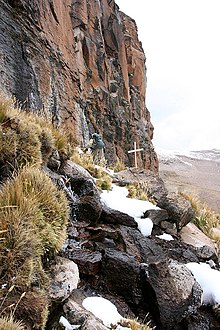Río Hornillos
| Río Hornillos | ||
|
Catchment area of Hornillos and Apurímac |
||
| Data | ||
| location |
|
|
| River system | Amazon | |
| Drain over | Río Apurímac → Río Ene → Río Tambo → Río Ucayali → Amazon → Atlantic | |
| Confluence of |
Río Challamayo and Río Alcata 15 ° 20 ′ 26 ″ S , 71 ° 41 ′ 58 ″ W |
|
| Source height | approx. 4520 m ( at the confluence ) | |
| muzzle | in the Río Apurímac coordinates: 15 ° 10 ′ 38 ″ S , 71 ° 38 ′ 9 ″ W 15 ° 10 ′ 38 ″ S , 71 ° 38 ′ 9 ″ W. |
|
| Mouth height | approx. 4150 m | |
| Height difference | approx. 370 m | |
| Bottom slope | approx. 12 ‰ | |
| length | 32 km (with Río Challamayo 65 km) | |
| Drain |
MQ |
6 m³ / s |
The Río Hornillos is a river in the Peruvian Andes . It belongs to the upper reaches of the Amazon and is counted with its left source river Challamayo and its source river Lloqueta to the longest source branch of the Amazon.
River course
Lloqueta
The Loqueta arises from the confluence of the Carhuasanta glacier streams (source on the northern slope of Nevado Mismi ) and Apacheta (source on the neighboring mountain Nevado Quehuisha ). After the confluence of the source streams, the Lloqueta flows north and joins the Ancollagua mountain stream coming from the west to form Challamayo after 12 km .
From around the beginning of the 1970s and until the mid-1990s, the Carhuasanta spring was considered to be the most distant source of the Amazon and was generally accepted as such. In contrast, the Apacheta spring on the Quehuisha was first proposed as the actual Amazon spring in 1996 by the Polish expedition leader Jacek Palkiewicz, a member of the Royal Geographical Society . In 2007, the accuracy of his discovery was confirmed by a Peruvian-Brazilian expedition, which consisted of experts from the Peruvian Instituto Geográfico Militar , the Peruvian water authority ANA, the Brazilian Geographical Institute IBGE and the Brazilian spatial research institute INPE. Since then, the Apacheta runoff is considered the authoritative source Amazon river and the source of the Nevado Quehuisha was September 11, 2011 by a marking plate of the Geographical Society of Lima marked as official source of the Amazon.
Challamayo
The 13 km long Challamayo flows north, then bends to the east and unites with the Alcata to the Hornillos.
Hornillos
From the confluence, the Hornillos runs to the southeast, then changes its direction of flow to the north and flows a good 30 km from the right into the Río Apurímac coming from the west .

